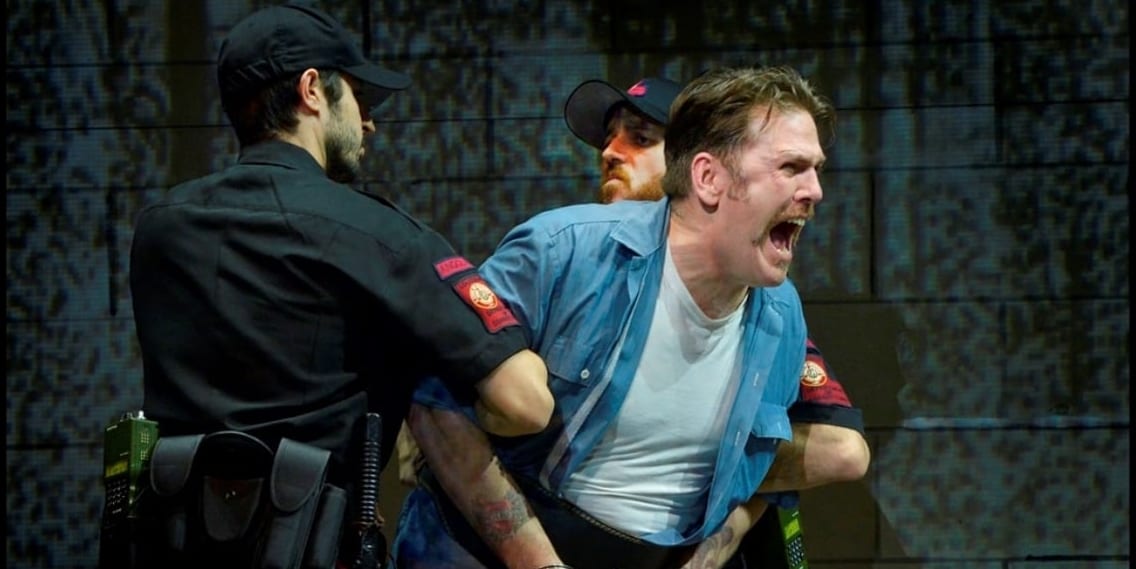Dead Man Walking is arguably the most performed contemporary American opera in the repertoire. This excellent production by the Israeli Opera provides all the good reasons to understand how it has gained such a status. All the elements of a good opera are effectively in place, and all are of the highest quality: the score itself by Jake Heggie, the singing and staging in this production, and the clear portrayal of the emotions of the characters. The opera is based on the mesmerizing true story of the American nun, Helen Prejean, an activist against the death sentence, who tries to comfort a convicted murderer on death row. It follows a powerful Tim Robbins movie of 1995, based on the same novel, starring Susan Sarandon and Sean Penn. The operatic version of Dead Man Walking was commissioned by the San Francisco Opera, where it had its debut in 2000.
After a short orchestral overture, the opera begins with a most dramatic and powerful prologue – the brutal murder of two teenagers by Joseph and Anthony de Rocher. From this very dark scene, we move right to a colourful and joyous children’s playground in Sister Helen’s mission. She reveals to her colleagues that she has been corresponding with an inmate on death row, who was asking her to be his spiritual adviser through his execution. She drives the very long way to the Louisiana State Penitentiary, where the rest of the plot takes place.
In his production, director Tomer Zvulun uses with great energy and imagination all the colours in his palette: stage and dress design, movement, lighting effects, video work, action. The outcome is dramatic, emotional and trustworthy. He responds with sincerity to the tale. If anyone needs a reminder that opera is not all about music, it is just as importantly about the drama, Zvulun makes a very strong case for it.
The two pillars of Dead Man Walking are the nun, Helen Prejean, sung by mezzo-soprano Maya Lahyani, and the murderer, Joseph de Roche, sung by Baritone Michael Mayes. Lahyani was powerful, restrained when needed and projected well the conflicts she is experiencing between good and evil, right and wrong, revenge and compassion. It is a very demanding role, as from her first appearance on the stage she does not leave it till the very end. The only reservation is that her English diction was not always clear enough. Mayes was a perfect choice for the role as if he was born for it. His look, voice and dramatic presence are hypnotizing. Another outstanding performance is given by mezzo-soprano Maria Zifchak as Joseph’s mother. For both Mayes and Zifchak it was their first performance in Israel. I look forward to their being brought back for other roles! Also noteworthy for both their dramatic interpretations and their musicality are Bass-Baritone Vladimir Brown as the Prison warden and Baritone Oded Reich as Owen Hart, the father of the murdered girl.
The music of Jake Heggie, a composer unknown to me before, follows the plot, enhancing its dramatic and emotional moments. It is definitely influenced by other great American composers – Gershwin and Bernstein, it seems to me, with a touch of Copland. It was artfully played by the orchestra under the baton of Patrick Summers in his Israeli Opera debut. Summers was the conductor of the world premiere of Dead Man Walking nineteen years ago and has a consummate grasp of the score and its demands.
It is a relatively short run for an opera in The Israeli Opera – 6 performances only. I guess that there were some doubts on how a 21st century, American opera would be received by Israel’s generally conservative audiences. The lengthy standing ovation at the conclusion of the debut performance, followed by a sellout of all other five performances, immediately thereafter, may have proven them to be too conservative themselves. But, of course, because of the success of this run of the opera, it is always possible to revive it at a future date!
PS There is a backstage drama before every performance – the audience is invited to join a 90 minutes tour (for a minimal fee) before curtain time, and sense the excitement on stage and in the soloists’ rooms and the make-up and wig rooms.

